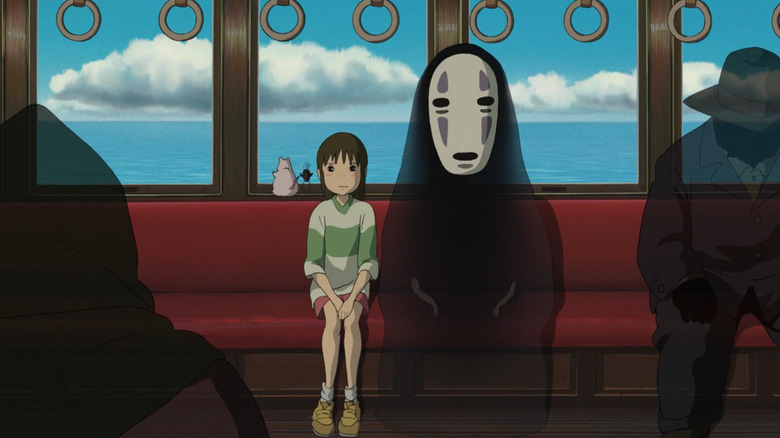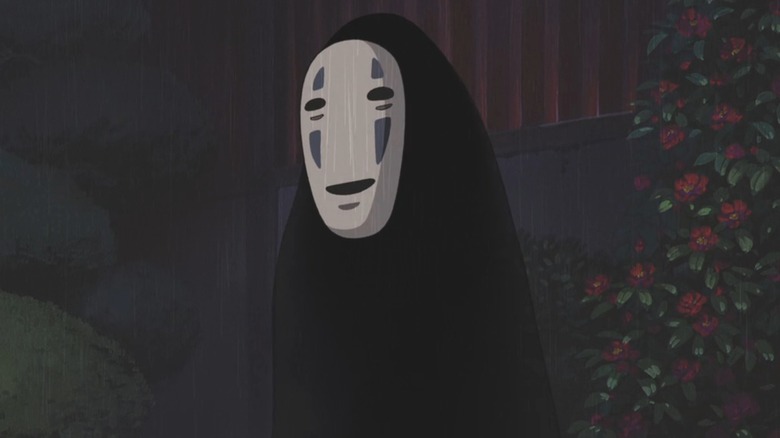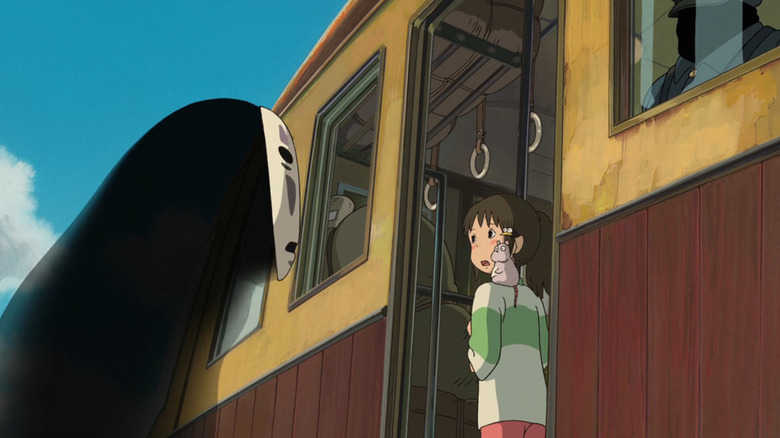What No-Face Really Represents In Spirited Away
One of the most perplexing characters in the 2001 film "Spirited Away" is No-Face. He's voiced by Akio Nakamura in the original version and by Bob Bergen in the English dub, although the character doesn't speak much; he mostly lingers and lurks, veering back and forth between creepy and pitiable. In a movie filled with strange creatures with bizarre traits and ambiguous morals, No-Face stands above the rest in most viewers' memories. He's the one featured most prominently in all the merch and who garners the most fandom speculation about his intentions.
On a literal plot level, No-Face's storyline is straightforward. He's a lonely spirit whom our protagonist Chihiro lets into the bathhouse, not knowing that she's not supposed to do that. No-Face seems obsessed with Chihiro and turns into an all-consuming monster in his apparent quest to get close to her. However, he's never portrayed as an outright villain; Chihiro flees his advances with relative ease, recognizes that his mind's been poisoned by all he's eaten, and casually lets him accompany her on a train to the witch Zeniba's house. It's there that No-Face finds his purpose, discovering that he's good at knitting. At the end, Chihiro leaves him behind at Zeniba's, and there's zero angst or conflict between the two characters.
This resolution to No-Face's storyline might feel anti-climactic, at least from a more traditional Hollywood plotting perspective. But the way No-Face fizzles out as a threat somehow feels true to life here, or at least true to the story that "Spirited Away" wants to tell.
What Hayao Miyazaki thinks No-Face represents
In a 2024 interview, Miyazaki offered his take on No-Face. "There are many people like No-Face in our midst," he reportedly said. "He's the type of person who wants to latch on to others but doesn't have a sense of themselves. They are everywhere."
It's an explanation that fits in nicely with the rest of the movie. Perhaps No-Face latches onto Chihiro so hard because when he first sees her, she's in a similar place as him. Chihiro in that first act of "Spirited Away" is someone who doesn't have a sense of self either, to the point where she straight-up has her name taken away from her. Chihiro spends the first third struggling to find her place in this strange spirit world. She's not actively trying to find her sense of self, but in her quest to save her parents, she finds it anyway.
It's easy to picture No-Face as having been initially intrigued by Chihiro as a fellow lost soul, only to grow obsessed upon seeing Chihiro come into her own working in the bathhouse. While No-Face is still alone and on the outside, Chihiro finds a sense of confidence and community in the bathhouse with surprising speed. Maybe that's why No-Face starts eating people and taking on their personalities; he's trying to find a shortcut to what Chihiro's earned, finding friends not through earnest hard work but through copying people's personalities and throwing money at people. No-Face eventually finds a similar sense of self to what Chihiro found earlier, but it takes him a lot longer to get there.
Why the true meaning of No-Face is ultimately up to the viewers
It's notable that, even after 20 years of fan speculation about No-Face, Miyazaki has been hesitant overall to offer his take on the character. And even when he did, it was a short and non-definitive explanation. Miyazaki might see No-Face as a representation of outsiders who lack a sense of self, but it doesn't seem like he wants to force that interpretation onto the viewers.
The beauty of "Spirited Away," much like the beauty of all of Miyazaki's films, is that there's enough room for viewers to make up their own minds about what they've seen. There aren't many lectures about what lessons we're supposed to take away, nor do any of the characters Chihiro meets fit themselves nicely into any kind of hero/villain dichotomy. "Spirited Away" trusts its viewers of all ages to embrace their imagination and come to their own conclusions, an approach that a lot of modern American animated movies (including some of the American dubs of Studio Ghibli movies) can learn from.
When it comes to what No-Face represents, it's truly up to you. He can be a metaphor for addiction, a metaphor for capitalism run wild, a metaphor for incels, and so on. Miyazaki has his own interpretation, but don't let that stop you from coming up with your own.


